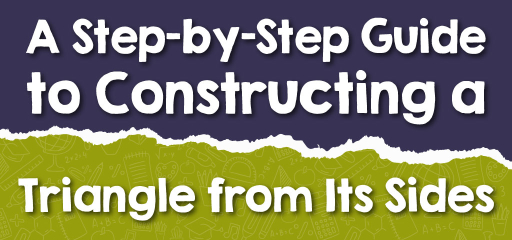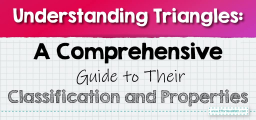A Step-by-Step Guide to Constructing a Triangle from Its Sides
In geometry, triangles are among the most basic and versatile shapes. Constructing a triangle using its three given sides is a fundamental skill. This guide will walk you through the steps and principles behind this construction, ensuring you can create accurate triangles with ease and precision.

Step-by-step Guide: Constructing a Triangle Given Its Sides
Tools Required:
- A straightedge or ruler.
- A compass.
- A pencil.
Procedure:
i. Laying the Base: Draw one of the triangle’s sides using your straightedge. Let’s name this side \(AB\).
ii. Constructing the Second Side: Choose one endpoint (let’s say \(A\)). Using your compass, set its width to the length of one of the other sides (let’s say \(AC\)). Then, draw a circular arc with \(A\) as the center.
iii. Constructing the Third Side: Similarly, set your compass to the length of the third side (let’s say \(BC\)). Place the compass point on \(B\) and draw another arc that intersects the previous arc.
iv. Finalizing the Triangle: Label the point where the arcs intersect as \(C\). Use your straightedge to connect points \(C\) to both \(A\) and \(B\). The resulting shape is the desired triangle \(ABC\).
Examples
Example 1:
You’re tasked with designing a triangular park, and you have been given the three side lengths but no angle measurements.
Solution:
Utilize the aforementioned method to draw the triangle accurately on a blueprint. Once constructed, you can proceed with additional design and landscaping within this triangular boundary.
Example 2:
You have side lengths \(5 \text{ cm}\), \(7 \text{ cm}\), and \(8 \text{ cm}\). Can a triangle be constructed with these sides?
Solution:
Yes. The sum of any two sides of a triangle (in this case, \(5 + 7 = 12\) and \(7 + 8 = 15\)) is greater than the third side (\(8 \text{ cm}\)). Thus, a triangle can be constructed using these lengths by following the steps mentioned.
Practice Questions:
- What conditions must three side lengths fulfill to construct a triangle?
- After constructing a triangle using three side lengths, how can you ascertain if it’s a right triangle?
- Using side lengths \(4 \text{ cm}\), \(6 \text{ cm}\), and \(11 \text{ cm}\), is triangle construction feasible?

Answers:
- The sum of any two side lengths must exceed the third. This principle is termed the triangle inequality theorem.
- Post-construction, apply the Pythagorean theorem to all sides. If the square of the longest side equals the sum of the squares of the other two, it’s a right triangle.
- No. The combined lengths of the shorter sides, \(4 + 6 = 10 \text{ cm}\), falls short of the longest side’s length \(11 \text{ cm}\). Triangle construction isn’t possible with these measurements due to the triangle inequality theorem.
Related to This Article
More math articles
- How to Define Sine, Cosine, and Tangent
- The Ultimate HSPT Math Course (+FREE Worksheets & Tests)
- How to Balance the Scales: Inequalities with Addition and Subtraction of Mixed Numbers
- FREE 5th Grade MEAP Math Practice Test
- Properties of Addition
- What skills Do I need for the GED Math Test?
- Algebra Puzzle – Challenge 38
- The Ultimate 7th Grade MAAP Math Course (+FREE Worksheets)
- How to Make Inferences from Data? (+FREE Worksheet!)
- Top 10 5th Grade PSSA Math Practice Questions


























What people say about "A Step-by-Step Guide to Constructing a Triangle from Its Sides - Effortless Math: We Help Students Learn to LOVE Mathematics"?
No one replied yet.